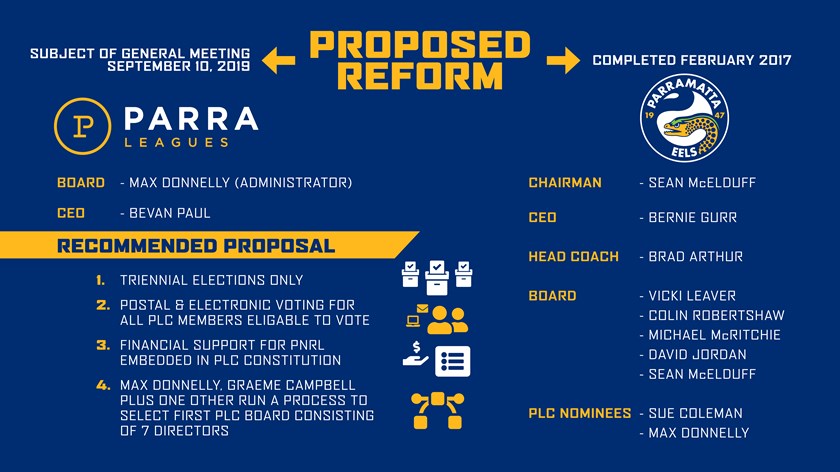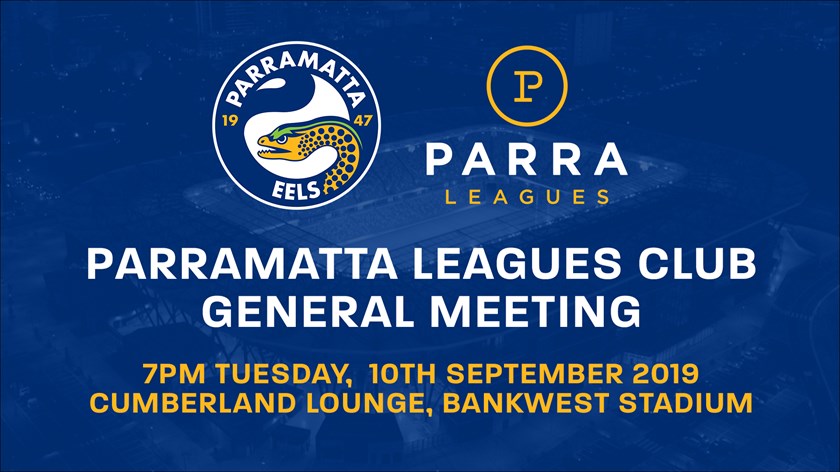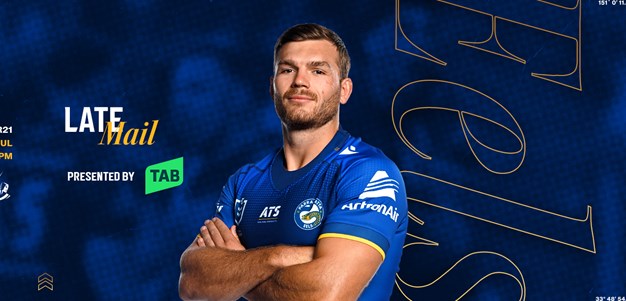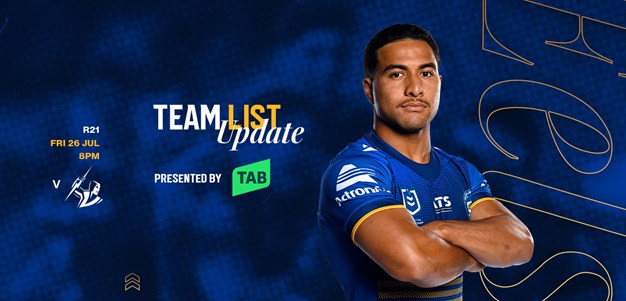Dear Members and Supporters,
All Parramatta Eels Club members (PLC) who are three-year financial members please Save the Date of 10th September 2019. The is the date for the meeting for a vote on constitutional reform at the Parramatta Leagues Club (“PLC”).
This is one of the most important meetings in the Parramatta Eels recent history as eligible PLC voting Members will have an opportunity to endorse important governance reforms that will ensure that the stability and growth that we have achieved over the last three years in the Football Club continues.
The Football Club with your support, is starting to move towards its rightful place as one of the premier sporting organisations in Australia. We are not there yet but we are heading in the right direction. To ensure we maintain the current level of stability and continue our period of growth, the Football Club is committed to supporting the PLC Administrator, Max Donnelly in his attempt to implement key reforms at the PLC.
It is critical to the ongoing success of the Parramatta Eels that we have stability on our Board. As such, we are asking all Eels Members and fans who are three-year financial members of the PLC to attend RSVP and attend the meeting.
For more details on reform and all FAQs please read the below.
Sean McElduff
Parramatta Eels Chairman


FAQs
Q. What is the relationship between the Parramatta Leagues Club (“PLC”) and the Parramatta National Rugby League Club (“the Football Club” or “PNRL”)?
A. The PLC is the owner of the Football Club and provides financial assistance and administrative support to both the Football Club and the Parramatta Junior League. The Football Club has its own CEO, Board and management team and they are responsible for the strategy and day to day management of the Football Club.
Both PLC and PNRL operate in complex regulatory environments and the structure now in place is the best for the company as a whole.
Q. I am a PNRL season ticket member, but not a PLC member. Can I vote?
A. No, only PLC Members with a minimum of 3-year continuous membership can vote in the elections. We encourage all PNRL Members to become members of the PLC so that can support the PLC and participate in voting in future elections after meeting the eligibility criteria.
Q. Who is currently managing the PLC?
A. In 2016, following the Salary Cap scandal where the Eels lost 12 competition points and Parramatta Leagues Club members bore the losses of the Eels which reached $12m in 2016, the Independent Liquor and Gaming Authority appointed Max Donnelly as the Administrator of PLC and he is supported by the CEO of the PLC, Bevan Paul.
PLC has a professional management team in place who support Bevan to oversee the running of the PLC and with the Administrator in place substantial progress has been made to develop the PLC’s assets. The Administrator, Max Donnelly functions as the Board and Governing Body of PLC. If the constitutional changes are supported – Max will hand back the governing of the PLC to the new PLC Board. He will no longer be involved with either the PLC or PNRL.
Q. What is the proposed constitutional reform for the PLC?
A. There are 4 key aspects to the PLC reform.
· That the Parramatta Eels be recognised in the PLC constitution for the first time. This means that that ownership and funding responsibility of the Parramatta Eels and Parramatta junior league will be formally outlined in the constitution.
· Provide for the Administrator to appoint the first Board and for the first Board election to take place in 2021.
· Introduce a triennial system for Member elections so that electing future PLC Board members is done in an orderly fashion, limiting constant changes caused by voting blocks and factions. Every year PLC members will vote to keep or replace a third of the Board members
· Introduce Postal and Electronic voting to ensure all eligible PLC Members can vote in future elections.
The Parramatta Eels Football Club and its Board plus management, staff, players and coaches are united in their support for the proposed PLC reforms.
Q. How will a stable PNRL help our football teams (NRL, elite juniors, women, junior clubs, touch, etc)
A. PNRL is the organisation that oversees and manages the entire football programme. A stable organisation is critical to ensure that all our football programs are run professionally so that we continue to achieve our aspiration as the premier Development Club. Previous instability at both a Board and management level has coincided with periods of poor on-field performance. This instability has played out on the football field with unsustainable losses which have restricted PLC’s growth.
Q. Why does the PNRL need a stable PLC?
A. Having a stable Board and Management team at PLC ensures that the PLC business is managed professionally so that it can continue to provide the same level of support into the future.
Further, a stable PLC and PNRL is a major community benefit as they can work together to provide benefits to their Members and the community it serves.
Based on previous elections, the uncertainty of a general election for the entire Board is a risk for stability. Resolution 1 at the September 6 AGM provides for a transition back to complete member control in a gradual fashion.
Q. Why isn’t there a need for constitutional reform at the Football Club?
A. This has already happened. Following the appointment of Max Donnelly in 2016 by the Independent Liquor and Gaming Authority (ILGA) as the Administrator of PLC, a new constitution of PNRL was put in place in early 2017 with a number of key governance reforms including the appointment of a separate Board to oversee the running of the Football Club.
This seven-person Football Club Board is made up 5 independent directors and two nominated directors from the PLC. The new constitution for the Football Club still acknowledges the 100% shareholding of PLC but ensures that the Football Club’s Board is responsible for the strategic direction and day to day management of the Football Club.
Q. Can the PLC take the Football Club’s funding away from the Football Club?
A. PLC is constitutionally obliged to financially support PNRL in a sustainable fashion. The new constitution strengthens this requirement.
Q. What were the disadvantages of the previous constitutional arrangements for the Football Club?
A. The previous constitutional arrangements meant that Football Club and PLC had the same Board of Directors and CEO. This meant that the general election every two years disrupted both the PLC and PNRL.
In the 7 years between 2009-2016 these arrangements led to constant board and management turnover especially in the football Club including: -
· Five different CEOs
· Five different Head Coaches
· Twenty-Five different Board Directors.
The constant change resulted in the on field and off field performance of the Football Club shifting to the bottom 25% of NRL Clubs on most metrics. This framework was also one of the reasons why multiple Directors between 2009 and 2016 (including the previous two Chair and Deputy Chair) were subject to investigations by ILGA and found to be not fit and proper people to be leading registered Clubs.
Lastly, the absence of postal and electronic voting meant that only a fraction of the eligible voters was able to have their say.
Separation of the boards ensure that directors of both PLC and PNRL are not conflicted when it comes to the best interests of the company and their membership.
Q. How will the first board be selected?
A. Max Donnelly will run a process to identify and select a Board via a nominations process. This process will be similar to the process used to select the Board of the Football Club which was appointed in 2017. The new PLC Board will be made up of PLC members (who have 3 years continuous membership).
Q. When will Max Donnelly retire as Administrator?
A. Assuming that the proposed reform is approved on the 10th September 2019, Max will commence a selection process for a new Board.
Q. When will PLC Members be able to vote for new Board Members?
A. Eligible PLC Members will be able to vote at the first General Meeting in February 2021 when the first triennial election cycle will start. The triennial rule is part of the Registered Clubs Act and is the preferred model for good governance. It means that a third of the board will stand for re-election each year enabling both refreshment of the Board if needed and stability. This avoids the risk of the entire board being replaced every two years and completely destabilising the company.
Does the Administrator need to submit the first board to ILGA for approval?
A. The Administrator will advise ILGA of his selections however it is unlikely that ILGA will play any direct role in the make-up of the PLC Board
Q. What will be the PLC policy for Board tenure?
A. As per the new constitution, a Director will be up for re-election every three years with maximum term being 10 years. In relation to the first Board, the seven appointed Directors will determine by lot (standard practice) with the initial terms with: -
· 2021: Two Directors must retire;
· 2022: Two Directors must retire;
· 2023: Three Directors must retire.
Q. What is the advantage of staggering board terms?
A. Having staggered board terms via the triennial rule is recognised as best practice by Clubs NSW because it avoids having wholesale changes (i.e. 7 directors at once) to the Board every election cycle while still providing opportunity to refresh the governing body when necessary. In addition, the triennial rule limits the impact of factions and voting tickets.
Q. After 15 months, how will people apply to become PLC board members?
A. The Board will determine the closing date for accepting nominations for the closing date of the first triennial election. Nominations for election as a Director will be made in writing and signed by two Full Members and by the nominee who must agree to act as a Director if elected. Director eligibility is outlined in Clause 9.3 in the PLC constitution.
Q. Who will determine the short list and who will oversee the vote of the first member-elected board members?
A. All elections will be overseen by a returning officer as per normal practice in Registered Clubs. This is a requirement of the Registered Clubs Act
Q. Will the new constitution prevent me from running for the PLC board?
A. Director eligibility is outlined in Clause 9.3 in the constitution
Q. How will the board decide who is first to leave?
A. In relation to the First Board, the seven appointed Directors will determine by lot (standard practice) the initial terms with: -
• 2021: Two Directors must retire;
• 2022: Two Directors must retire;
• 2023: Three Directors must retire.
Q. How many PLC board members can sit on the Football Club Board (“PNRL”)? How will these be determined?
A. The PLC Board will nominate two directors for the Football Club Board. This will be determined through a resolution by the PLC Board however the Chairman/President of PLC cannot be one of the nominees. This will ensure that PLC interests are represented and that the PLC Board is kept up to date on PNRL progress.
Q. If the vote is unsuccessful for constitutional reform, what happens next?
A. the Administrator will remain in place until sufficient constitutional reform is in place. ILGA is determined to have constitutional reform implemented in the PLC. If necessary, PNRL will engage with ILGA and the Government on further measures for reforms to be put in place. However, our preference is for these to be adopted at the General Meeting by a Member vote on 10th September.
Q. Who oversees the Football Club?
A. The Football Club has its own Board comprising of:
· Sean McElduff - Chairman
· Col Robertshaw - Deputy Chairman.
· Vicki Leaver - Director
· Michael McRitchie - Director
· David Jordan - Director
· Max Donnelly - PLC Nominee
· Sue Coleman - PLC Nominee.
If the PLC reform is approved on September 10th 2019, both Max Donnelly and Sue Coleman will step down from the Football Club Board to allow two PLC directors to take their positions.
Q. What are the sources of revenue for the Football Club?
A. The Football Club’s revenue sources include:
· Membership revenue.
· Corporate Sponsorship.
· Corporate Hospitality.
· Ticketing revenue.
· Merchandise revenue.
· An allocation of funding from broadcastings rights from the NRL.
· An allocation of funding from the PLC. Since the new PNRL Board started, the reliance for funding from the PLC has reduced from $12 million (2016) to $3.5million (2018)







